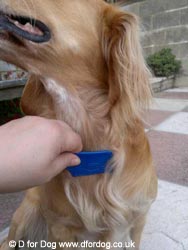Dog Fleas - Preventing, Spotting and Treating
Fleas… who’d have them? Well unfortunately many dogs and cats have or are playing host to these nasty little critters. And what was once considered to be only a late summer and early autumn problem is now potentially a year round issue for most of our pets living with us in warm, carpeted homes.

Fleas are external parasites. They live off the blood of their host. They are incredibly hardy, able to go without a meal for a number of months. Fleas can also jump amazing distances, from environment to host and from host to host.
These jumping, biting pests are much more than just an itchy problem. If the irritation was not bad enough, they can also cause sore skin and infections from the dog chewing and scratching, transmit diseases and tape worms and even cause anaemia in severe infestations or in unwell, small, young or old dogs. Dogs can also develop an allergy to flea saliva, causing even more discomfort, scratching, risk of infections and hot spots.
Spotting a flea infestation
If your pet is scratching, biting or licking more than usual, fleas should be suspected. But it is actually not as easy as you might think to pinpoint a flea infestation. Fleas love to hide in nooks and crannies such as the dog’s armpits or at the head or tail end. Parting your dog’s fur for even a thorough flea search might be futile, even if fleas are in fact present. But it is important, if you suspect fleas, to find out for sure and treat the problem as soon as possible.
If you don’t actually see a flea when parting the fur for an inspection, look out for any dark specks in the fur or on the skin. Finding flea dirt is an absolute give away but how to tell it apart from actual dirt?
Buy a good quality metal toothed dog flea comb, stand your dog in a safe place on a damp white towel and start combing from the top down. If any dirt lands on the towel causing a red-brown stain as it gets damp and spreads, it is likely to be flea dirt. Flea droppings contain blood that the flea has ingested.
Preventing and dealing with fleas

With so many products on the market it can be difficult to know which to try. Topical flea products are very common, such as spot-on treatments. Other flea treatments come in the form of sprays, oral treatments, flea collars and shampoos. They can be used for prevention all year round as per the product instructions. Alternatively, many dog owners resort to them only if a flea infestation occurs.
Flea and parasite treatments vary widely. It is important to know exactly what parasites the particular treatment does and does not protect your dog from, for how long, and how often it should be administered. It is also important to know your dog’s weight before you purchase and use these products, so that you use the correct dose for your pet. And don’t make the mistake of using too many different kinds of flea products at once, unless your vet specifically advises it.
A new solution on the market uses bioactivation to minimise chemical exposure, making it safer for the dog being treated. This new pro-insecticide indoxacarb formula only forms a potent insecticide once it is inside the flea. It also claims to be effective at all stages of the flea life cycle, so claims to tackle the flea issue on the dog as well as the developing flea eggs in the environment.
Many dog owners prefer to try natural parasite deterrents rather than potentially harmful insecticides, especially if simply attempting to prevent a flea infestation. Lavender and neem oil are often considered to be insect repellents. Many essential oil blends are available on the market to try. Brewers Yeast and garlic are also thought to repel fleas. As garlic is believed to accumulate in the system, it is best to follow a one week on, one week off regime.
Although natural options seem safer, there is no ‘scientific’ evidence that they work and care should still be taken even when using what we refer to as natural remedies. A natural or holistic vet would be able to advise you further, especially if your dog takes any other supplements, remedies or medications or suffers from any medical issues.
When dealing with a flea infestation you need to target the fleas and the flea eggs. You need to treat not only your dog but everything in the dog’s environment that could harbour fleas, including bedding, carpets, grass, soft furnishings and so on. Getting the fleas off your dog is actually the easiest part of the de-flea process. The more difficult part is dealing with the hundreds of eggs that the females will have laid which then drop off your dog. For every female flea on your dog you can easily expect a couple of hundred eggs in the home environment.

Wash your dog’s bedding at a high temperature. Thorough vacuuming is also a great start. Pay particularly close attention to places your dog likes to sleep, all room edges and corners, soft furnishings and under furniture. Securely seal, dispose of and replace the vacuum cleaner bag each time. You could even put some flea powder or a flea collar in the bag.
However, vacuuming alone won’t necessarily remove all fleas or flea eggs. Any remaining fleas and eggs may have to be destroyed to break the cycle. Again there are many products on the market such as sprays and powders. If using these read all labels carefully and follow the instructions. And don’t forget outside areas such as kennels, patios and even grass. Keep grass short and sweep up any piles of leaves or anything that provides a nice safe potential flea home.
Unfortunately you may have to carry out a thorough cleaning of your home and garden for a number of months before the final fleas and eggs are removed or destroyed and the cycle is well and truly broken. As mentioned, fleas can lie dormant and unfed for a number of months. Stop too soon and you can quickly find your dog and home infested once more.
Whether you prefer prevention or cure, you have the choice of many commercial, chemical and natural products to try. You should also make sure your dog is in the best possible health. Fleas love weakened animals. Keep your dog’s immune system strong and healthy with a good diet, clean healthy living and appropriate exercise. Even if your dog still gets the odd unwanted flea, you can’t go far wrong with that advice.
By Jenny Prevel
© D for Dog www.dfordog.co.uk
This article belongs strictly to D for Dog and we do not authorise the copying of all or any part of it.

Recently our dog and cat who receive regular frontline treatment had an infestation of fleas. We tried most of the treatments from vets and pet stores to no avail. We put the dog into the sea and when got home the fleas dropped off so we covered every room in house plus pets bedding with salt and left for 24hrs in mean time we washed all bedding including our own. After 24hrs we vaccume everything and now we are flea free. Salt is the answer.